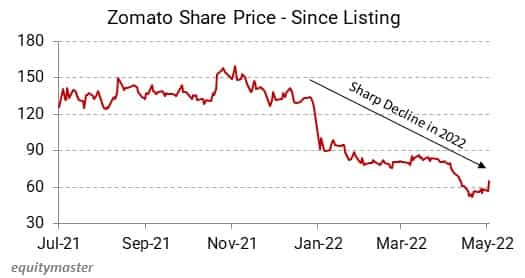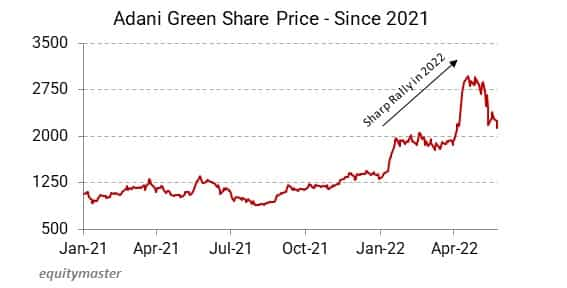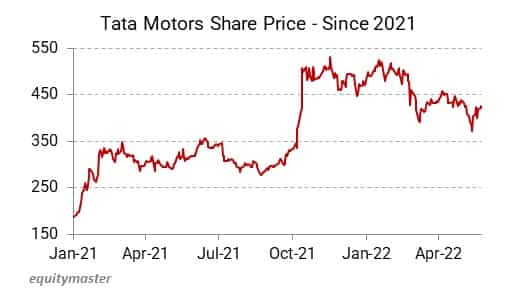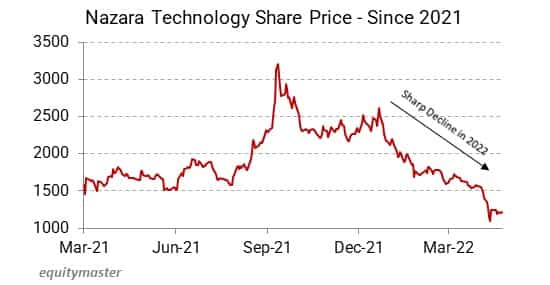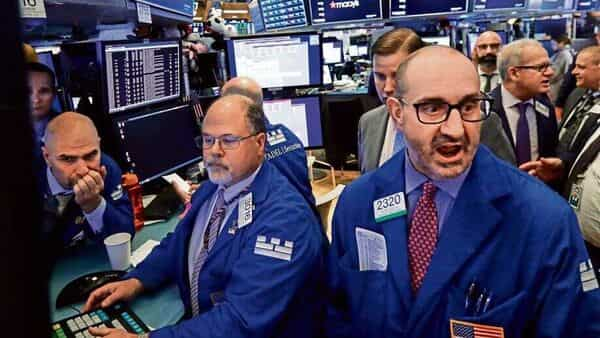A strong recovery from the Covid-19 downturn, record-high initial public offerings (IPOs), coupled with extra liquidity in the economy drove the markets.
Although, an interesting change in dynamic was witnessed in 2021. Retail investors enthusiastically made up for the heavy selling observed by foreign institutional investors (FIIs).
FIIs remained net sellers for six out of twelve months in 2021 and have continued their downward trend in 2022 so far.
In spite of substantial FII outflows, India’s benchmark BSE Sensex reached its highest level in October 2021 and logged a whopping 21% return for the year.
This tells us retail investors and DIIs were the only large buyers in the market. In other words, if retail investors stop or reduce their buying activity, the market will face a very tough time.
Some of this was witnessed in May 2022 when retail investors pulled money out of the markets to apply for Life Insurance Corporation (LIC) IPO.
Nonetheless, in 2021 a good number of stocks saw a sharp rally. But which were the most popular stocks of 2021?
Have these stocks performed well in 2022? Or have they eroded massive investor wealth?
Read on to find out how the most popular stocks of 2021 are performing now…
#1 Zomato
No surprises here.
Being the second largest public offer of the year in terms of money raised, Zomato was unarguably one of the most buzzing IPOs in Indian history.
It was also the first tech company which laid out the groundwork for other tech companies to launch their IPOs.
Zomato launched its IPO in July 2021 asking for investments of up to ₹93.75 bn. Though the company was making losses and had rich valuations, the IPO got oversubscribed 38.25 times.
Zomato got listed at a premium of 51% to its issue price. The upward momentum continued for the next few months before going down a slippery slope in 2022.
Have a look at the chart below which will show you the journey of Zomato since listing.
![Equitymaster Equitymaster]() View Full ImageEquitymaster
View Full ImageEquitymaster
Since the start of 2022, Zomato is down 52.7%.
In early 2022, Zomato shares went into heavy correction amid the meltdown in stocks of other major new-age companies like Nykaa, CarTrade Tech, and Paytm.
Investor sentiment further dampened by weak financial results reported for the December 2021 quarter. The Russia-Ukraine war accelerated the market selloff.
The company, like its peers, is facing cash flow problems. The operational costs run quite high and it’s unable to bring it below its cash inflows. Thus, it’s reporting huge losses.
Moreover, the business model of Zomato provides little scope for increasing prices to meet the operational costs.
The recent scenario of interest rate hikes has also impacted the new-age tech stocks. In volatile times like these, investors prefer to hold stocks with good profitability and high cash flows instead of growth companies.
Zomato has wiped out half of investor wealth in the current financial year.
#2 Restaurant Brands India
Restaurant Brands India (erstwhile Burger King India) operates as a franchisee of Burger King. It’s one of the fastest growing international quick service restaurant chains in the country.
As the national master franchisee of the Burger King brand in India, the company has exclusive rights to develop, operate, and franchise Burger King branded restaurants.
Incorporated in 2013, the company has established nearly 260 restaurants across major cities.
Restaurant Brands’ shares made their stock market debut on 14 December 2020 and were listed at a 92% premium whereas the stock closed 130% higher on its first day of trading.
The issue was the second most subscribed IPO of 2020 as it was subscribed 156 times.
Take a look at the chart below which presents the stock price performance of the scrip since 2021.
![Equitymaster Equitymaster]() View Full ImageEquitymaster
View Full ImageEquitymaster
The stock is down 33% in 2022 so far.
Primarily, the shares took a dive in February 2022, as fresh shares allotted by the company to qualified institutional buyers (QIBs) started trading on the exchanges on 18 February.
The company had raised ₹14 bn through qualified institutional placement (QIP) by issuing 108.5 m equity shares to eligible QIBs.
In subsequent three trading sessions, the stock dropped 23% and fell below the QIP’s issue price of ₹129.95 apiece.
The company intended to partly use the QIP funds to purchase Burger King Indonesia, which is the second major reason for the plunge.
The financials of Burger King Indonesia are not promising. Their earnings have been steadily decreasing amid tough competition in the Indonesian market.
Although there’s one noteworthy aspect, Restaurant Brands Asia currently has no debt on its balance sheet, which is rare for a loss-making growth company.
#3 Adani Green
The list would be incomplete without featuring at least one Adani group company.
Headquartered in Ahmedabad, Adani Green Energy is an Indian renewable energy company.
The company has a project portfolio of 13,990 MW and 20,284 MW of locked-in growth from under-construction assets as of December 2021.
Interestingly, Adani Green is also one of the best performing stocks since the March 2020 crash, giving around 1,379% returns in two years.
The stock is up over 60% in 2022 so far.
![Equitymaster Equitymaster]() View Full ImageEquitymaster
View Full ImageEquitymaster
The hike in April 2022 is due to the 56% year-on-year surge in operational capacity during the fourth quarter of fiscal 2022. The YoY energy sale jumped 84% during the same quarter.
Although, the stock has been consolidating for the last month. This could majorly be attributed to interest rate hike by the central bank to combat inflation.
Adani Green funds all its capital expenditure through debt from holding companies, debentures, and foreign currency loans.
With further hikes in sight, Adani Green might feel the burden on its books. The company failed to generate positive free cash flows in the 2021 fiscal.
#4 Tata Motors
Neither the global semiconductor shortage nor the battering by the second covid wave could hamper the near 160% rise in Tata Motors’ stock in 2021. The stock outperformed the benchmark indices by a mile.
Tata Motors witnessed a hike despite the company reporting consolidated net losses led by weakness in its subsidiary Jaguar Land Rover.
The success of US-based Tesla Inc and the central government’s push towards electrification of the automobile sector nudged investors to search for companies that could benefit from the technological disruption.
Tata Motors’ electric vehicle plans got a huge boost on the back of nearly US$ 1 bn investment by TPG Rise in its EV subsidiary.
Take a look at the chart of Tata Motor’s share price performance.
![Equitymaster Equitymaster]() View Full ImageEquitymaster
View Full ImageEquitymaster
Post a steep rally in October 2021, Tata Motors is down 15% in the current calendar year.
The plunge could be attributed to the weak financial results of December 2021 quarter.
Finally, the semiconductor shortage weighed in on the automaker as retail sales for the October-December 2021 quarter remained constrained.
On quarterly basis, retail sales were down 13.6% while on a yearly basis sales were down 37.6%.
Further, the anticipated economic slowdown could heavily impact the already lagging industry.
#5 Nazara Technologies
2021 had been an astronomical period for the Indian primary market with 63 companies collectively raising ₹1.2 bn through their maiden offers – the highest amount ever raised in a single calendar year.
Nazara Technologies was one such company to come out with its IPO. It is backed by ace investor Rakesh Jhunjhunwala.
The company is the leading India based diversified gaming and sports media platform with a presence in India and across emerging and developed global markets such as Africa and North America.
The company derives revenues mainly from subscription fees paid by users for accessing gamified early learning content, as well as, from the eSports business.
It made a stellar debut on the bourses on 30 March 2021 as the shares of the firm listed at ₹1,990, an 81% over its issue price of ₹1,101 on the National Stock Exchange (NSE). Post-listing, it moved higher to ₹2,026.9, up 84%.
Have a look at the chart below which will show you the company’s journey since listing.
![Equitymaster Equitymaster]() View Full ImageEquitymaster
View Full ImageEquitymaster
In September 2021, Nazara Technologies outperformed the benchmark indices, rallying 20.3%.
A strong smallcap rally coupled with strong growth projections for the mobile gaming market in India with competition only from unlisted players had led to a bullish trend.
However, the stock has tumbled in 2022. Headwinds caused by a change in Apple policies and regulatory environment in real money gaming in India and the negative impact of Covid-19 in the e-sports segment may have soured investors’ sentiment.
Despite such challenges, the revenue from operations increased by 42% while the consolidated profit increased by 17% in March 2022.
Nazara Technologies is down 48.6% in 2022 so far.
The anticipated global economic slowdown could heavily impact the industry going forward.
But remember that the gaming addiction in India has just started. We haven’t seen anything yet.
Nazaara technologies, the only listed player in the online gaming industry, has a massive market waiting to be captured. There are many unlisted firms in this space too.
Keep this equation in mind…
Favourable demographics + internet penetration + smart phone coverage + purchasing power = Huge Long-Term Profits.
The takeaway?
The stock market is an expensive place to learn investing. The market takes away your money first and then gives you the lesson.
This has been the story of many popular scrips. Stocks riding high on easy money have come crashing down.
As we’ve written before, 2022 will be a difficult year for investors. There is a higher chance of losing money over the coming months compared to any period since March 2020.
And that’s exactly what has been happening. Currently, the markets are extremely volatile. So you must be extremely careful in selecting the best stocks to invest.
Here’s what Co-head of Research at Equitymaster Tanushree Banerjee has to say about selecting stocks…
The profits hereon won’t be easy money. You will need to carefully select your stocks, assess the risks, insist on a margin of safety, and make timely exits. The reason I say this is because, the trend of too much money chasing too few good stocks is reversing. The rising interest rate cycle could now reverse the direction of fund flows globally. Also, the post pandemic recovery is well factored into earnings projections and market valuations. So from now on, I believe the earnings recovery could be disproportionately high only in rare economic circumstances.
Do remember that opportunity can be found in any adversity. Hence, you can gain from the current environment if you invest carefully.
Now if you do plan to invest, then aim at investing for a long term to reap maximum benefits.
Happy investing!
Disclaimer: This article is for information purposes only. It is not a stock recommendation and should not be treated as such.
This article is syndicated from Equitymaster.com
Subscribe to Mint Newsletters * Enter a valid email * Thank you for subscribing to our newsletter.
.





